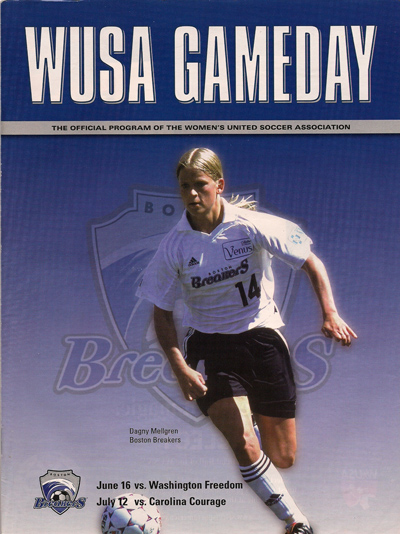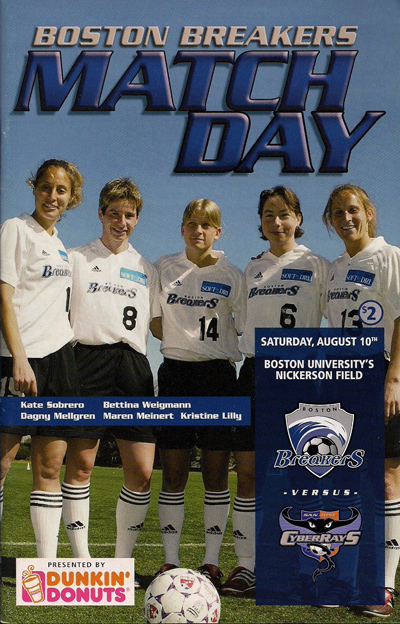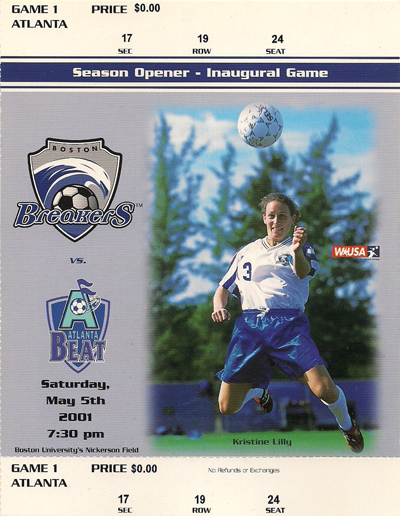Women’s United Soccer Association (2001-2003)
Tombstone
Born: April 10, 2000 – WUSA founding franchise
Folded: September 15, 2003
First Game: April 21, 2001 (W 1-0 @ Carolina Courage)
Last Game: August 16, 2003 (L 0-0, 3-1 on penalty kicks vs. Washington Freedom)
Founders Cup Championships: None
Stadium
Nickerson Field (10,000)12002 Boston Breakers Media Guide
Marketing
Team Colors: Breaker Blue, Sea Silver & Surf White22002 Boston Breakers Media Guide
Mascot: Sweeper (the Seal)
Ownership
Investor-Operator: Amos Hostetter
Attendance
Tilting your mobile device may offer better viewing.
Sources:
- 2002 Boston Breakers Media Guide (2001 Breakers & WUSA figures)
- Bickelhaupt, Susan. “WUSA opts to suspend operations”. The Globe (Boston, MA). September 16, 2003
Record Book
WUSA Most Valuable Player
- 2003: Maren Meinert
WUSA Coach-of-the-Year
- 2003: Pia Sundhage
WUSA Executive-of-the-Year
- 2002: Joe Cummings
- 2003: Joe Cummings
Background
The original Boston Breakers soccer club was a founding member of the Women’s United Soccer Association (WUSA) from 2001 to 2003. The WUSA was the first professional soccer league for women in North America, backed by a consortium of cable television companies and executives who were intrigued by the groundbreaking success of the 1999 FIFA Women’s World Cup, hosted by the United States. The Breakers franchise was backed by Amos Hostetter, the billionaire co-founder of Continental Cablevision.
The provenance of the team’s name was somewhat odd. Like many fledgling sports teams, the Boston franchise held a Name-The-Team contest. A 15-year old teenage girl from suburban Easton, Massachusetts sent in the winning nomination. What was strange about the choice was that Boston already had a high profile pro sports flop that had used the same identity in the recent past. The Boston Breakers of the United States Football League had even used a similar blue/white color scheme and played in the very same stadium (Boston University’s Nickerson Field) as the new women’s soccer team. The football Breakers came and went in a single season in 1983 – very much in the living memory of countless local sports fans and Boston’s sporting press.
Building the Breakers
But “Breakers” it was to be. In May of 2000, each of the eight WUSA franchises received three players from the United States Women’s National Team that captivated the nation during the World Cup ten months earlier. The U.S. National Teamers – known as “Founders” since they also had a small equity stake in the league – were meant to form both the talent nucleus and the marketing tent poles for each franchise. The Breakers received All-Universe midfielder Kristine Lilly and stalwart defender Kate Sobrero. The team’s third allocation, however, was a bust. Tracy Ducar, the USWNT’s reserve goalkeeper, suffered an eye-injury late in the WUSA’s 2001 debut season. Canadian National Team goalkeeper Karina LeBlanc permanently unseated Ducar for the Breakers starting job.
The burden of scoring goals fell to the Breakers’ international signings. Boston received German National Team stars Maren Meinert and Bettina Wiegmann along with the Norwegian duo of Ragnhild Gulbrandsen (who would join in 2002) and Dagny Mellgren. Gulbrandsen would disappoint and Wiegmann retired after two seasons. But Meinert and Mellgren quickly emerged as premier scoring threats, with Lilly often setting the table with deft assists.
Despite fine individual performances from the likes of Lilly, Meinert, Mellgren and a previously unheralded University of Virginia midfielder named Angela Hucles, the Breakers disappointed as a team during the first two seasons of the WUSA. Under Head Coach Jay Hoffman, the team finished 6th place and out of the playoffs in both campaigns. The Breakers were also something of a Jekyll & Hyde club – virtually unbeatable at home, where they had established one of the most loyal followings in the WUSA, but unable to perform consistently on the road.
2003: Sundhage & Meinert Lead Breakers to 1st Place
The club’s fortunes turned in 2003 with the hiring of Swedish manager Pia Sundhage to take over for Hoffman. The Breakers finally became a tough road team, equaling their success at home. Meinert was phenomenal at the top of the attack, winning league Most Valuable Player honors. At 10-4-7, the Breakers finished top of the table in the WUSA’s regular season. However, Boston was bounced on penalty kicks in the playoff semi-final by the eventual league champion Washington Freedom.
One month later, the WUSA abruptly closed its doors on September 15, 2003. There were inklings that the league was in trouble. The league cut roster sizes from 18 to 16 following the 2002 season and dropped the salary cap from $834,500 to $595,750.3French, Scott. “WUSA – Founding players take pay cuts”. Soccer America. March 25, 2003 The “Founders” (mostly) accepted large pay cuts. But it wasn’t enough. While attendance was not far off from expectations, corporate sponsorship for the league never hit critical mass. Still, the timing of the shutdown shocked many outside observers. The closure came just five days before the start of the 2003 Women’s World Cup where the USWNT would defend their historic 1999 triumph.
Revival Efforts
A lackluster effort to revive corporate support for the WUSA through a series of neutral-site “festivals” in the summer of 2004 flopped. From 2004 through 2008, there was no top-flight women’s pro soccer league in North America. When a new league – Women’s Professional Soccer (WPS) – began play in 2009, organizers quickly awarded a franchise to Boston. The WPS franchise revived the Breakers name and logo. The “New” Breakers of 2009 included three veterans of the original 2001-2003 Breakers club: Hucles, Lilly and seldom-used Mary-Frances Monroe. The team also featured several front office holdovers who returned to work for the new club, including Team President Joe Cummings, who launched both editions of the team.
The new/2009 edition of the Breakers lasted through nine seasons and three different leagues. Breakers 2.0 folded due to financial exhaustion in January 2018.
Boston Breakers Shop
[auction-nudge tool=”listings”]
Boston Breakers Video
2002 Boston Breakers In-Stadium Video Montage (starts around 0:18)…
Downloads
2003 Boston Breakers Ticket Brochure
2003 Boston Breakers Ticket Brochure
Links
###




